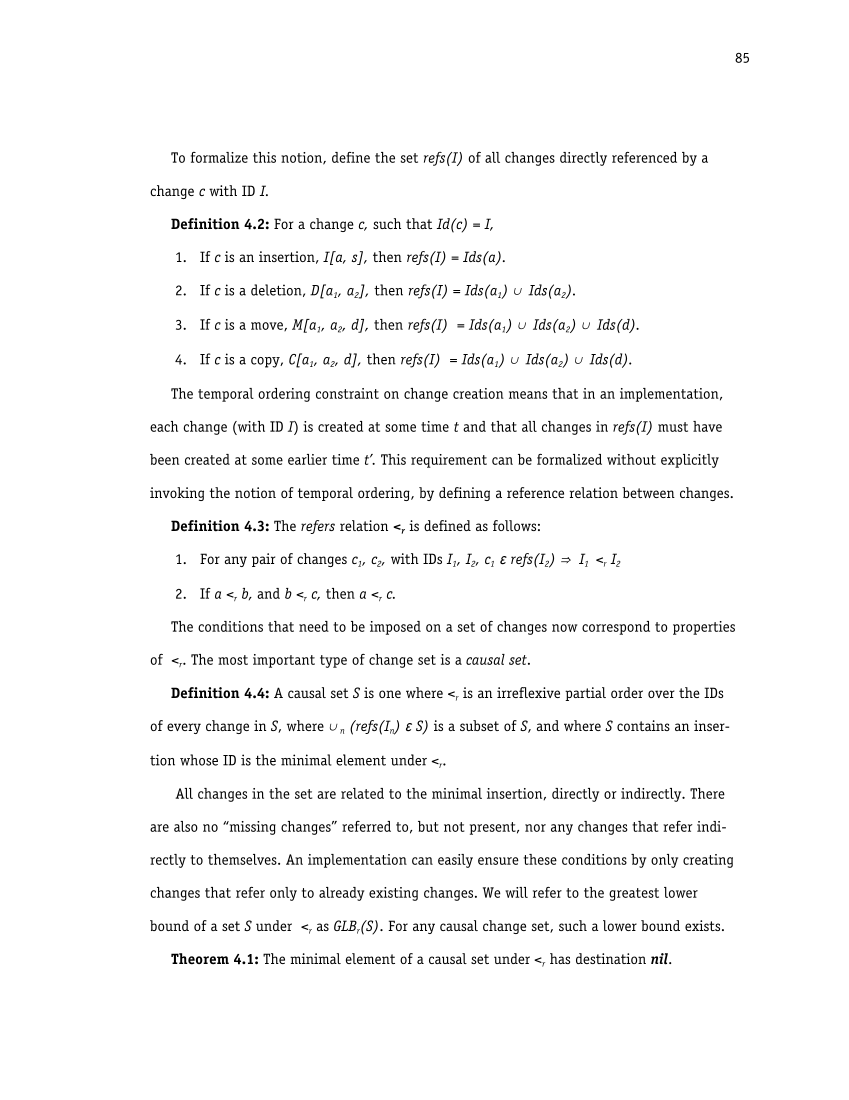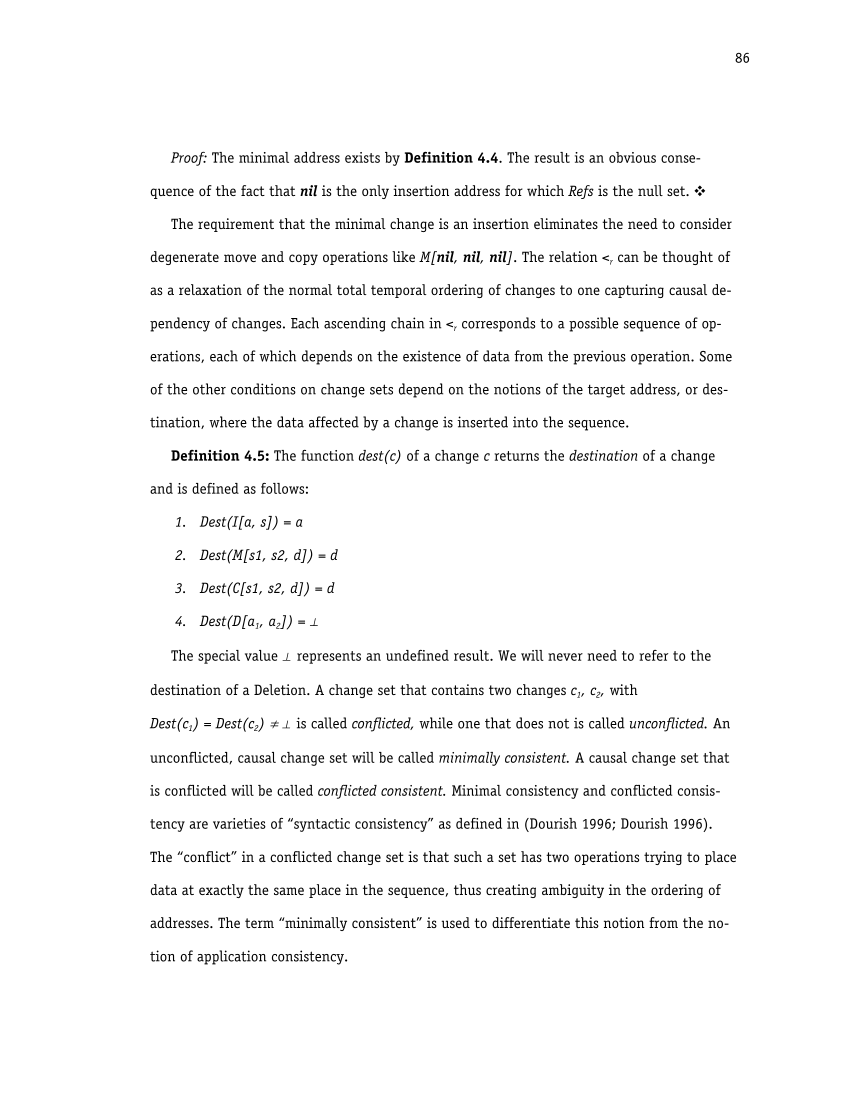85
To�formalize�this�notion,�define�the�set�refs(I)of�all�changes�directly�referenced�by�a
change�cwith�IDI.
Definition�4.2:For�a�changec,such�thatId(c) = I,
1. Ifcis�an�insertion,I[a, s],�thenrefs(I) = Ids(a).
2. Ifcis�a�deletion,D[a
1 , a
2 ],�thenrefs(I) = Ids(a
1 )�¨ Ids(a
2 ).
3. Ifcis�a�move,M[a
1 , a
2 , d],�thenrefs(I) = Ids(a
1 ) ¨ Ids(a
2 ) ¨ Ids(d).
4. Ifcis�a�copy,C[a
1 , a
2 , d],�thenrefs(I) = Ids(a
1 ) ¨ Ids(a
2 ) ¨ Ids(d).
The�temporal�ordering�constraint�on�change�creation�means�that�in�an�implementation,
each�change�(with�ID�I)�is�created�at�some�timetand�that�all�changes�inrefs(I)must�have
been�created�at�some�earlier�time�t’. This�requirement�can�be�formalized�without�explicitly
invoking�the�notion�of�temporal�ordering,�by�defining�a�reference�relation�between�changes.
Definition�4.3:Therefersrelation<
r is�defined�as�follows:
1. For�any�pair�of�changesc
1 ,�c
2 ,�with�IDsI
1 ,�I
2 ,�c
1 e refs(I
2 ) I
1 <
r I
2
2. Ifa <
r b,andb <
r c,thena <
r c.
The�conditions�that�need�to�be�imposed�on�a�set�of�changes�now�correspond�to�properties
of <
r .�The�most�important�type�of�change�set�is�a�causal�set.
Definition�4.4:A�causal�setSis�one�where<
r is�an�irreflexive�partial�order�over�the�IDs
of�every�change�in�S,�where¨
n (refs(I
n ) e S)�is�a�subset�ofS,�and�whereScontains�an�inser-
tion�whose�ID�is�the�minimal�element�under<
r .
All�changes�in�the�set�are�related�to�the�minimal�insertion,�directly�or�indirectly.�There
are�also�no�“missing�changes”�referred�to,�but�not�present,�nor�any�changes�that�refer�indi-
rectly�to�themselves.�An�implementation�can�easily�ensure�these�conditions�by�only�creating
changes�that�refer�only�to�already�existing�changes.�We�will�refer�to�the�greatest�lower
bound�of�a�set�Sunder<
r as�GLB
r (S).�For�any�causal�change�set,�such�a�lower�bound�exists.
Theorem�4.1:The�minimal�element�of�a�causal�set�under<
r has�destination�nil.
To�formalize�this�notion,�define�the�set�refs(I)of�all�changes�directly�referenced�by�a
change�cwith�IDI.
Definition�4.2:For�a�changec,such�thatId(c) = I,
1. Ifcis�an�insertion,I[a, s],�thenrefs(I) = Ids(a).
2. Ifcis�a�deletion,D[a
1 , a
2 ],�thenrefs(I) = Ids(a
1 )�¨ Ids(a
2 ).
3. Ifcis�a�move,M[a
1 , a
2 , d],�thenrefs(I) = Ids(a
1 ) ¨ Ids(a
2 ) ¨ Ids(d).
4. Ifcis�a�copy,C[a
1 , a
2 , d],�thenrefs(I) = Ids(a
1 ) ¨ Ids(a
2 ) ¨ Ids(d).
The�temporal�ordering�constraint�on�change�creation�means�that�in�an�implementation,
each�change�(with�ID�I)�is�created�at�some�timetand�that�all�changes�inrefs(I)must�have
been�created�at�some�earlier�time�t’. This�requirement�can�be�formalized�without�explicitly
invoking�the�notion�of�temporal�ordering,�by�defining�a�reference�relation�between�changes.
Definition�4.3:Therefersrelation<
r is�defined�as�follows:
1. For�any�pair�of�changesc
1 ,�c
2 ,�with�IDsI
1 ,�I
2 ,�c
1 e refs(I
2 ) I
1 <
r I
2
2. Ifa <
r b,andb <
r c,thena <
r c.
The�conditions�that�need�to�be�imposed�on�a�set�of�changes�now�correspond�to�properties
of <
r .�The�most�important�type�of�change�set�is�a�causal�set.
Definition�4.4:A�causal�setSis�one�where<
r is�an�irreflexive�partial�order�over�the�IDs
of�every�change�in�S,�where¨
n (refs(I
n ) e S)�is�a�subset�ofS,�and�whereScontains�an�inser-
tion�whose�ID�is�the�minimal�element�under<
r .
All�changes�in�the�set�are�related�to�the�minimal�insertion,�directly�or�indirectly.�There
are�also�no�“missing�changes”�referred�to,�but�not�present,�nor�any�changes�that�refer�indi-
rectly�to�themselves.�An�implementation�can�easily�ensure�these�conditions�by�only�creating
changes�that�refer�only�to�already�existing�changes.�We�will�refer�to�the�greatest�lower
bound�of�a�set�Sunder<
r as�GLB
r (S).�For�any�causal�change�set,�such�a�lower�bound�exists.
Theorem�4.1:The�minimal�element�of�a�causal�set�under<
r has�destination�nil.





























































































































































































